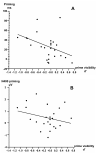Top-down modulation of unconscious 'automatic' processes: A gating framework
- PMID: 20517515
- PMCID: PMC2864982
- DOI: 10.2478/v10053-008-0032-2
Top-down modulation of unconscious 'automatic' processes: A gating framework
Abstract
In classical theories of automaticity, automatic processes are usually thought to occur autonomously and independently of higher level top-down factors (e.g., Posner & Snyder, 1975). However, already Neumann (1984) pointed out that the cognitive system has to be configured in a certain way for automatic processes to occur. In extension of his work, I propose a gating framework to account for the influence of top-down factors such as attention, intention and task set on automatic processes such as masked response or semantic priming. It is assumed that task representations held in prefrontal cortex regulate the gain of neurons in visual and sematic association cortex thereby modulating the effects of unconsciously perceived masked stimuli on further 'automatic' information processing steps. In support of the postulated gating framework, recent studies demonstrated a top-down modulation of automatic processes. Behavioral and electrophysiological studies with the masked response priming and semantic priming paradigms show that masked priming effects crucially depend (i) on temporal attention to the masked prime, (ii) on intentions or action plans and (iii) on the task set active immediately before masked prime presentation. For instance, masked semantic priming was only observed when the preceding task set required the orientation to semantic word features, but not when it required orientation to perceptual word features. These results support the view that unconscious automatic processes are modulated by top-down factors. They are suggestive of a gating mechanism which orchestrates the conscious and unconscious information processing streams.
Keywords: automatic processes; masked response priming; masked semantic; priming; top-down control; unconscious perception.
Figures






Similar articles
-
Attentional sensitization of unconscious visual processing: Top-down influences on masked priming.Adv Cogn Psychol. 2012;8(1):50-61. doi: 10.2478/v10053-008-0102-4. Epub 2012 Feb 15. Adv Cogn Psychol. 2012. PMID: 22419966 Free PMC article.
-
Specifying attentional top-down influences on subsequent unconscious semantic processing.Adv Cogn Psychol. 2009 Aug 21;5:56-68. doi: 10.2478/v10053-008-0067-3. Adv Cogn Psychol. 2009. PMID: 20523850 Free PMC article.
-
Unconscious semantic processing of polysemous words is not automatic.Neurosci Conscious. 2016 Aug 6;2016(1):niw010. doi: 10.1093/nc/niw010. eCollection 2016. Neurosci Conscious. 2016. PMID: 30109129 Free PMC article.
-
Unconscious vision and executive control: how unconscious processing and conscious action control interact.Conscious Cogn. 2014 Jul;27:268-87. doi: 10.1016/j.concog.2014.05.009. Epub 2014 Jun 22. Conscious Cogn. 2014. PMID: 24960432 Review.
-
[Schizophrenia and semantic priming effects].Encephale. 2006 Jan-Feb;32(1 Pt 1):75-82. doi: 10.1016/s0013-7006(06)76139-5. Encephale. 2006. PMID: 16633293 Review. French.
Cited by
-
The effect of inter-letter spacing on the N170 during visual word recognition: An event-related potentials experiment.Cogn Affect Behav Neurosci. 2024 Dec;24(6):1096-1108. doi: 10.3758/s13415-024-01221-9. Epub 2024 Sep 23. Cogn Affect Behav Neurosci. 2024. PMID: 39313747 Free PMC article.
-
Evidence for implicit self-positivity bias: an event-related brain potential study.Exp Brain Res. 2014 Mar;232(3):985-94. doi: 10.1007/s00221-013-3810-z. Epub 2014 Jan 7. Exp Brain Res. 2014. PMID: 24395142
-
The Intensity of Early Attentional Processing, but Not Conflict Monitoring, Determines the Size of Subliminal Response Conflicts.Front Hum Neurosci. 2019 Feb 20;13:53. doi: 10.3389/fnhum.2019.00053. eCollection 2019. Front Hum Neurosci. 2019. PMID: 30842733 Free PMC article.
-
Unconscious knowledge: A survey.Adv Cogn Psychol. 2010;6:116-41. doi: 10.2478/v10053-008-0081-5. Epub 2011 Mar 4. Adv Cogn Psychol. 2010. PMID: 21814538 Free PMC article.
-
Subliminal Emotional Words Impact Syntactic Processing: Evidence from Performance and Event-Related Brain Potentials.Front Hum Neurosci. 2017 Apr 25;11:192. doi: 10.3389/fnhum.2017.00192. eCollection 2017. Front Hum Neurosci. 2017. PMID: 28487640 Free PMC article.
References
-
- Abrams R. L., Greenwald A. G. Parts outweigh the whole (word) in unconscious analysis of meaning. Psychological Science. 2000;11:118–124. - PubMed
-
- Allport A., Styles E. A., Hsieh S. Shifting intentional set: Exploring the dynamic control of tasks.. In: Umilta C., Moscovitch M., editors. Attention and Performance 15: Conscious and Nonconscious Information Processing. Attention and Performance Series; Cambridge, MA, US: The MIT Press; 1994. pp. 421–452.
-
- Anderson J. R., Bower G. H. Human associative memory. Washington, DC: Hemisphere Press; 1973.
-
- Ansorge U. Top-down contingencies of nonconscious priming revealed by dual-task interference. Quarterly Journal of Experimental Psychology. 2004;57A:1123–1148. - PubMed
-
- Ansorge U., Heumann M., Scharlau I. Influences of visibility, intentions, and probability in a peripheral cuing task. Consciousness and Cognition. 2002;11:528–545. - PubMed
LinkOut - more resources
Full Text Sources
